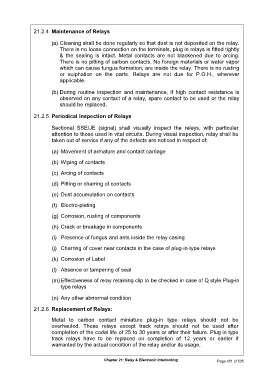Page 508 - IRSEM_Main Book
P. 508
21.2.4 Maintenance of Relays
(a) Cleaning shall be done regularly so that dust is not deposited on the relay.
There is no loose connection on the terminals, plug in relays is fitted tightly
& the sealing is intact. Metal contacts are not blackened due to arcing.
There is no pitting of carbon contacts. No foreign materials or water vapor
which can cause fungus formation, are inside the relay. There is no rusting
or sulphation on the parts. Relays are not due for P.O.H., wherever
applicable.
(b) During routine inspection and maintenance, if high contact resistance is
observed on any contact of a relay, spare contact to be used or the relay
should be replaced.
21.2.5 Periodical Inspection of Relays
Sectional SSE/JE (signal) shall visually inspect the relays, with particular
attention to those used in vital circuits. During visual inspection, relay shall be
taken out of service if any of the defects are noticed in respect of;
(a) Movement of armature and contact carriage
(b) Wiping of contacts
(c) Arcing of contacts
(d) Pitting or charring of contacts
(e) Dust accumulation on contacts
(f) Electro-plating
(g) Corrosion, rusting of components
(h) Crack or breakage in components
(i) Presence of fungus and ants inside the relay casing
(j) Charring of cover near contacts in the case of plug-in-type relays
(k) Corrosion of Label
(l) Absence or tampering of seal
(m) Effectiveness of relay retaining clip to be checked in case of Q style Plug-in
type relays
(n) Any other abnormal condition
21.2.6 Replacement of Relays:
Metal to carbon contact miniature plug-in type relays should not be
overhauled. These relays except track relays should not be used after
completion of the codal life of 25 to 30 years or after their failure. Plug in type
track relays have to be replaced on completion of 12 years or earlier if
warranted by the actual condition of the relay and/or its usage.
Chapter 21: Relay & Electronic Interlocking Page 451 of 535

